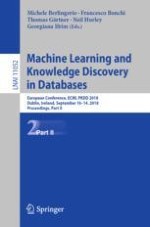The three volume proceedings LNAI 11051 – 11053 constitutes the refereed proceedings of the European Conference on Machine Learning and Knowledge Discovery in Databases, ECML PKDD 2018, held in Dublin, Ireland, in September 2018.
The total of 131 regular papers presented in part I and part II was carefully reviewed and selected from 535 submissions; there are 52 papers in the applied data science, nectar and demo track.
The contributions were organized in topical sections named as follows:
Part I: adversarial learning; anomaly and outlier detection; applications; classification; clustering and unsupervised learning; deep learningensemble methods; and evaluation.
Part II: graphs; kernel methods; learning paradigms; matrix and tensor analysis; online and active learning; pattern and sequence mining; probabilistic models and statistical methods; recommender systems; and transfer learning.
Part III: ADS data science applications; ADS e-commerce; ADS engineering and design; ADS financial and security; ADS health; ADS sensing and positioning; nectar track; and demo track.
